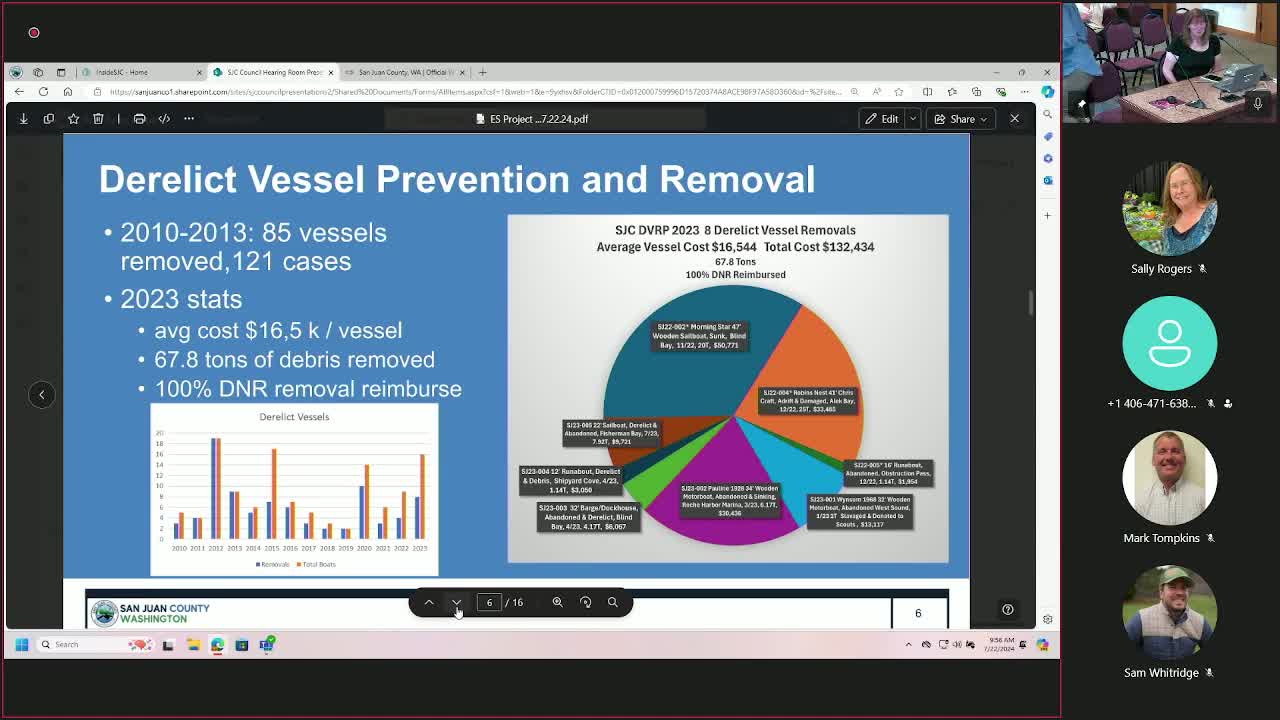Vessel removal program tackles derelict boats and environmental risks
July 22, 2024 | San Juan County, Washington

This article was created by AI summarizing key points discussed. AI makes mistakes, so for full details and context, please refer to the video of the full meeting. Please report any errors so we can fix them. Report an error »

In a recent government meeting, Carrie Koski, the newly appointed coordinator for derelict vessel prevention and removal, provided an update on the program's activities and challenges. Over the past decade, the program has successfully removed 85 derelict vessels, with 121 cases reported. In 2023 alone, eight vessels were removed, with costs averaging around $16,000 per removal, highlighting the financial burden associated with derelict vessel management.
Koski emphasized the importance of prevention, noting that proactive measures can significantly reduce costs and environmental risks. This year, a collaborative vessel removal event led to the successful removal of 14 vessels, demonstrating the effectiveness of partnerships with organizations like the Department of Natural Resources (DNR) and local ports.
Despite these successes, funding remains a critical issue. The program currently relies on state reimbursements, which primarily cover removal costs rather than prevention efforts. Koski pointed out that as the program focuses more on prevention, the potential for state funding may diminish, creating a need for alternative funding strategies. The county's budget for the program is limited, with only $15,000 allocated for current expenses.
Council members expressed interest in exploring additional funding sources, particularly in light of the increasing number of derelict vessels in the area. The discussion highlighted the need for a sustainable funding model to ensure the program's long-term viability and effectiveness in maintaining the marine environment.
Koski concluded by reiterating the program's commitment to preventing environmental damage and fostering responsible vessel ownership, while also acknowledging the ongoing challenges in securing adequate funding for these essential efforts.
Koski emphasized the importance of prevention, noting that proactive measures can significantly reduce costs and environmental risks. This year, a collaborative vessel removal event led to the successful removal of 14 vessels, demonstrating the effectiveness of partnerships with organizations like the Department of Natural Resources (DNR) and local ports.
Despite these successes, funding remains a critical issue. The program currently relies on state reimbursements, which primarily cover removal costs rather than prevention efforts. Koski pointed out that as the program focuses more on prevention, the potential for state funding may diminish, creating a need for alternative funding strategies. The county's budget for the program is limited, with only $15,000 allocated for current expenses.
Council members expressed interest in exploring additional funding sources, particularly in light of the increasing number of derelict vessels in the area. The discussion highlighted the need for a sustainable funding model to ensure the program's long-term viability and effectiveness in maintaining the marine environment.
Koski concluded by reiterating the program's commitment to preventing environmental damage and fostering responsible vessel ownership, while also acknowledging the ongoing challenges in securing adequate funding for these essential efforts.
View full meeting
This article is based on a recent meeting—watch the full video and explore the complete transcript for deeper insights into the discussion.
View full meeting
